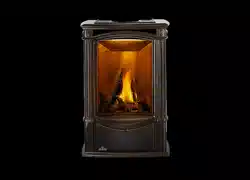Loading ...
Loading ...
Loading ...

W415-2360 / A / 10.31.19
EN
52
troubleshooting
SYMPTOM PROBLEM TEST SOLUTION
Continues to spark
and pilot lights, but
main burner will not
light.
Short or loose
connection in sensor rod.
- Verify all connections. Verify the connections from the pilot
assembly are tight; also verify these connections are not
grounding out to any metal.
Poor fl ame rectifi cation
or contaminated
sensor rod.
- Verify the fl ame is engulfi ng the sensor rod. This will increase
the fl ame rectifi cation. Verify correct pilot orifi ce is installed
and inlet gas specifi cations to manual. (Remember, the fl ame
carries the rectifi cation current, not the gas. If the fl ame lifts
from pilot hood, the circuit is broken. A wrong orifi ce or to
high of an inlet pressure can cause the pilot fl ame to lift.) The
sensor rod may need cleaning.
Poor grounding between
pilot assembly and
gas valve.
- Verify that the wire harness is fi rmly connected to module.
Verify that the ceramic insulator around the sensor rod is not
cracked, damaged, or loose. Verify the connection from the
sensor rod to the sensor wire.
Damaged pilot or dirty
sensor rod.
- Clean sensor rod with a fi ne emery cloth or synthetic
scrub pad to remove any contamination that may have
accumulated on the sensor rod. Verify continuity with
multimeter with ohms set at the lowest range.
Pilot lights
Stops sparking
/ pilot remains lit
but burner will
not turn on.
Wiring / Connection. - Inspect all wires, ensure good tight connections. Verify that
all wiring is installed exactly as specifi ed.
Wiring harness. - Inspect the wiring harness, and verify the harness is
tightly connected to the module. Verify that all wires are
connected in the right order. See “WIRING DIAGRAM”
section.
Exhaust fumes
smelled in room,
headaches.
Appliance is spilling. - Check all seals.
- Check if exhaust is re-entering through an open door or
window.
White / grey fi lm
forms.
Sulphur from fuel is being depos-
ited on glass, logs or combus-
tion chamber
surfaces.
- Clean the glass, see “CARE OF GLASS” section
- DO NOT CLEAN GLASS WHEN HOT.
- If deposits are not cleaned off regularly, the glass may
become permanently marked.
Flames are very ag-
gressive.
Door is ajar. - Tighten door clamps if applicable.
Venting action is too great. - Restrict vent exit with restrictor plate. See “RESTRICTING
VENTS” section if applicable.
Main burner fl ame is
a blue, lazy, trans-
parent
fl ame.
Blockage in vent. - Remove blockage. In extreme conditions, ice buildup may
occur on the terminal and should be removed. To minimize
this from happening again, it is recommended that the
vent lengths that pass through unheated spaces (attics,
garages, crawl spaces) be wrapped with an insulated mylar
sleeve. Prevent sleeve from sagging. Contact your local
authorized dealer for more information.
Compromised venting.
- Check venting system parameters (seal, length, rise, etc.).
Main burner goes
out: pilot goes out.
Vent recirculation. - Check joint seals and installation.
Loading ...
Loading ...
Loading ...
